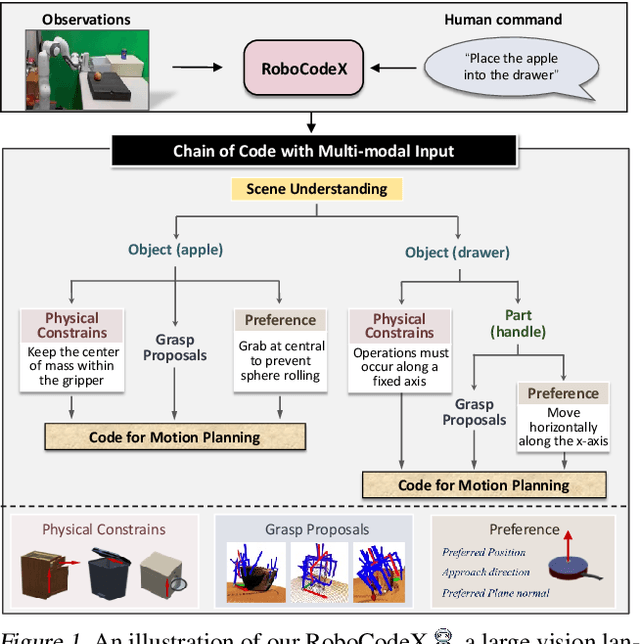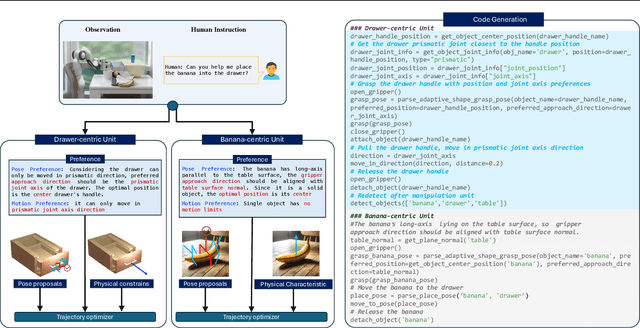Chongjian Ge
Character Mixing for Video Generation
Oct 06, 2025Abstract:Imagine Mr. Bean stepping into Tom and Jerry--can we generate videos where characters interact naturally across different worlds? We study inter-character interaction in text-to-video generation, where the key challenge is to preserve each character's identity and behaviors while enabling coherent cross-context interaction. This is difficult because characters may never have coexisted and because mixing styles often causes style delusion, where realistic characters appear cartoonish or vice versa. We introduce a framework that tackles these issues with Cross-Character Embedding (CCE), which learns identity and behavioral logic across multimodal sources, and Cross-Character Augmentation (CCA), which enriches training with synthetic co-existence and mixed-style data. Together, these techniques allow natural interactions between previously uncoexistent characters without losing stylistic fidelity. Experiments on a curated benchmark of cartoons and live-action series with 10 characters show clear improvements in identity preservation, interaction quality, and robustness to style delusion, enabling new forms of generative storytelling.Additional results and videos are available on our project page: https://tingtingliao.github.io/mimix/.
A Generative Foundation Model for Chest Radiography
Sep 04, 2025Abstract:The scarcity of well-annotated diverse medical images is a major hurdle for developing reliable AI models in healthcare. Substantial technical advances have been made in generative foundation models for natural images. Here we develop `ChexGen', a generative vision-language foundation model that introduces a unified framework for text-, mask-, and bounding box-guided synthesis of chest radiographs. Built upon the latent diffusion transformer architecture, ChexGen was pretrained on the largest curated chest X-ray dataset to date, consisting of 960,000 radiograph-report pairs. ChexGen achieves accurate synthesis of radiographs through expert evaluations and quantitative metrics. We demonstrate the utility of ChexGen for training data augmentation and supervised pretraining, which led to performance improvements across disease classification, detection, and segmentation tasks using a small fraction of training data. Further, our model enables the creation of diverse patient cohorts that enhance model fairness by detecting and mitigating demographic biases. Our study supports the transformative role of generative foundation models in building more accurate, data-efficient, and equitable medical AI systems.
PixelFlow: Pixel-Space Generative Models with Flow
Apr 10, 2025



Abstract:We present PixelFlow, a family of image generation models that operate directly in the raw pixel space, in contrast to the predominant latent-space models. This approach simplifies the image generation process by eliminating the need for a pre-trained Variational Autoencoder (VAE) and enabling the whole model end-to-end trainable. Through efficient cascade flow modeling, PixelFlow achieves affordable computation cost in pixel space. It achieves an FID of 1.98 on 256$\times$256 ImageNet class-conditional image generation benchmark. The qualitative text-to-image results demonstrate that PixelFlow excels in image quality, artistry, and semantic control. We hope this new paradigm will inspire and open up new opportunities for next-generation visual generation models. Code and models are available at https://github.com/ShoufaChen/PixelFlow.
Goku: Flow Based Video Generative Foundation Models
Feb 10, 2025



Abstract:This paper introduces Goku, a state-of-the-art family of joint image-and-video generation models leveraging rectified flow Transformers to achieve industry-leading performance. We detail the foundational elements enabling high-quality visual generation, including the data curation pipeline, model architecture design, flow formulation, and advanced infrastructure for efficient and robust large-scale training. The Goku models demonstrate superior performance in both qualitative and quantitative evaluations, setting new benchmarks across major tasks. Specifically, Goku achieves 0.76 on GenEval and 83.65 on DPG-Bench for text-to-image generation, and 84.85 on VBench for text-to-video tasks. We believe that this work provides valuable insights and practical advancements for the research community in developing joint image-and-video generation models.
FlashVideo:Flowing Fidelity to Detail for Efficient High-Resolution Video Generation
Feb 07, 2025Abstract:DiT diffusion models have achieved great success in text-to-video generation, leveraging their scalability in model capacity and data scale. High content and motion fidelity aligned with text prompts, however, often require large model parameters and a substantial number of function evaluations (NFEs). Realistic and visually appealing details are typically reflected in high resolution outputs, further amplifying computational demands especially for single stage DiT models. To address these challenges, we propose a novel two stage framework, FlashVideo, which strategically allocates model capacity and NFEs across stages to balance generation fidelity and quality. In the first stage, prompt fidelity is prioritized through a low resolution generation process utilizing large parameters and sufficient NFEs to enhance computational efficiency. The second stage establishes flow matching between low and high resolutions, effectively generating fine details with minimal NFEs. Quantitative and visual results demonstrate that FlashVideo achieves state-of-the-art high resolution video generation with superior computational efficiency. Additionally, the two-stage design enables users to preview the initial output before committing to full resolution generation, thereby significantly reducing computational costs and wait times as well as enhancing commercial viability .
CompGS: Unleashing 2D Compositionality for Compositional Text-to-3D via Dynamically Optimizing 3D Gaussians
Oct 28, 2024



Abstract:Recent breakthroughs in text-guided image generation have significantly advanced the field of 3D generation. While generating a single high-quality 3D object is now feasible, generating multiple objects with reasonable interactions within a 3D space, a.k.a. compositional 3D generation, presents substantial challenges. This paper introduces CompGS, a novel generative framework that employs 3D Gaussian Splatting (GS) for efficient, compositional text-to-3D content generation. To achieve this goal, two core designs are proposed: (1) 3D Gaussians Initialization with 2D compositionality: We transfer the well-established 2D compositionality to initialize the Gaussian parameters on an entity-by-entity basis, ensuring both consistent 3D priors for each entity and reasonable interactions among multiple entities; (2) Dynamic Optimization: We propose a dynamic strategy to optimize 3D Gaussians using Score Distillation Sampling (SDS) loss. CompGS first automatically decomposes 3D Gaussians into distinct entity parts, enabling optimization at both the entity and composition levels. Additionally, CompGS optimizes across objects of varying scales by dynamically adjusting the spatial parameters of each entity, enhancing the generation of fine-grained details, particularly in smaller entities. Qualitative comparisons and quantitative evaluations on T3Bench demonstrate the effectiveness of CompGS in generating compositional 3D objects with superior image quality and semantic alignment over existing methods. CompGS can also be easily extended to controllable 3D editing, facilitating scene generation. We hope CompGS will provide new insights to the compositional 3D generation. Project page: https://chongjiange.github.io/compgs.html.
WOMD-Reasoning: A Large-Scale Language Dataset for Interaction and Driving Intentions Reasoning
Jul 05, 2024



Abstract:We propose Waymo Open Motion Dataset-Reasoning (WOMD-Reasoning), a language annotation dataset built on WOMD, with a focus on describing and reasoning interactions and intentions in driving scenarios. Previous language datasets primarily captured interactions caused by close distances. However, interactions induced by traffic rules and human intentions, which can occur over long distances, are yet sufficiently covered, despite being very common and more challenging for prediction or planning models to understand. Therefore, our WOMD-Reasoning focuses extensively on these interactions, providing a total of 409k Q&As for varying types of interactions. Additionally, WOMD-Reasoning presents by far the largest Q&A dataset on real-world driving scenarios, with around 3 million Q&As covering various topics of autonomous driving from map descriptions, motion status descriptions, to narratives and analyses of agents' interactions, behaviors, and intentions. This extensive textual information enables fine-tuning driving-related Large Language Models (LLMs) for a wide range of applications like scene description, prediction, planning, etc. By incorporating interaction and intention language from WOMD-Reasoning, we see significant enhancements in the performance of the state-of-the-art trajectory prediction model, Multipath++, with improvements of 10.14% in $MR_6$ and 6.90% in $minFDE_6$, proving the effectiveness of WOMD-Reasoning. We hope WOMD-Reasoning would empower LLMs in driving to offer better interaction understanding and behavioral reasoning. The dataset is available on https://waymo.com/open/download .
PixArt-Σ: Weak-to-Strong Training of Diffusion Transformer for 4K Text-to-Image Generation
Mar 07, 2024



Abstract:In this paper, we introduce PixArt-\Sigma, a Diffusion Transformer model~(DiT) capable of directly generating images at 4K resolution. PixArt-\Sigma represents a significant advancement over its predecessor, PixArt-\alpha, offering images of markedly higher fidelity and improved alignment with text prompts. A key feature of PixArt-\Sigma is its training efficiency. Leveraging the foundational pre-training of PixArt-\alpha, it evolves from the `weaker' baseline to a `stronger' model via incorporating higher quality data, a process we term "weak-to-strong training". The advancements in PixArt-\Sigma are twofold: (1) High-Quality Training Data: PixArt-\Sigma incorporates superior-quality image data, paired with more precise and detailed image captions. (2) Efficient Token Compression: we propose a novel attention module within the DiT framework that compresses both keys and values, significantly improving efficiency and facilitating ultra-high-resolution image generation. Thanks to these improvements, PixArt-\Sigma achieves superior image quality and user prompt adherence capabilities with significantly smaller model size (0.6B parameters) than existing text-to-image diffusion models, such as SDXL (2.6B parameters) and SD Cascade (5.1B parameters). Moreover, PixArt-\Sigma's capability to generate 4K images supports the creation of high-resolution posters and wallpapers, efficiently bolstering the production of high-quality visual content in industries such as film and gaming.
RoboCodeX: Multimodal Code Generation for Robotic Behavior Synthesis
Feb 25, 2024



Abstract:Robotic behavior synthesis, the problem of understanding multimodal inputs and generating precise physical control for robots, is an important part of Embodied AI. Despite successes in applying multimodal large language models for high-level understanding, it remains challenging to translate these conceptual understandings into detailed robotic actions while achieving generalization across various scenarios. In this paper, we propose a tree-structured multimodal code generation framework for generalized robotic behavior synthesis, termed RoboCodeX. RoboCodeX decomposes high-level human instructions into multiple object-centric manipulation units consisting of physical preferences such as affordance and safety constraints, and applies code generation to introduce generalization ability across various robotics platforms. To further enhance the capability to map conceptual and perceptual understanding into control commands, a specialized multimodal reasoning dataset is collected for pre-training and an iterative self-updating methodology is introduced for supervised fine-tuning. Extensive experiments demonstrate that RoboCodeX achieves state-of-the-art performance in both simulators and real robots on four different kinds of manipulation tasks and one navigation task.
Advancing Vision Transformers with Group-Mix Attention
Nov 26, 2023



Abstract:Vision Transformers (ViTs) have been shown to enhance visual recognition through modeling long-range dependencies with multi-head self-attention (MHSA), which is typically formulated as Query-Key-Value computation. However, the attention map generated from the Query and Key captures only token-to-token correlations at one single granularity. In this paper, we argue that self-attention should have a more comprehensive mechanism to capture correlations among tokens and groups (i.e., multiple adjacent tokens) for higher representational capacity. Thereby, we propose Group-Mix Attention (GMA) as an advanced replacement for traditional self-attention, which can simultaneously capture token-to-token, token-to-group, and group-to-group correlations with various group sizes. To this end, GMA splits the Query, Key, and Value into segments uniformly and performs different group aggregations to generate group proxies. The attention map is computed based on the mixtures of tokens and group proxies and used to re-combine the tokens and groups in Value. Based on GMA, we introduce a powerful backbone, namely GroupMixFormer, which achieves state-of-the-art performance in image classification, object detection, and semantic segmentation with fewer parameters than existing models. For instance, GroupMixFormer-L (with 70.3M parameters and 384^2 input) attains 86.2% Top-1 accuracy on ImageNet-1K without external data, while GroupMixFormer-B (with 45.8M parameters) attains 51.2% mIoU on ADE20K.
 Add to Chrome
Add to Chrome Add to Firefox
Add to Firefox Add to Edge
Add to Edge